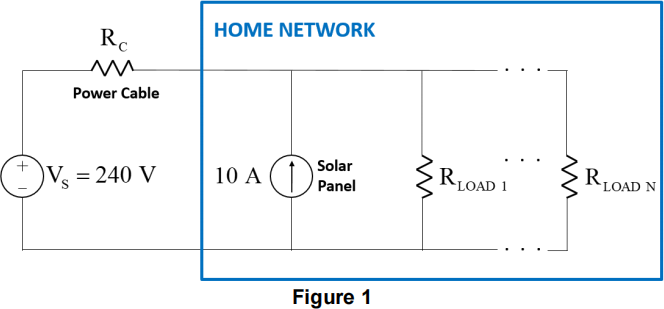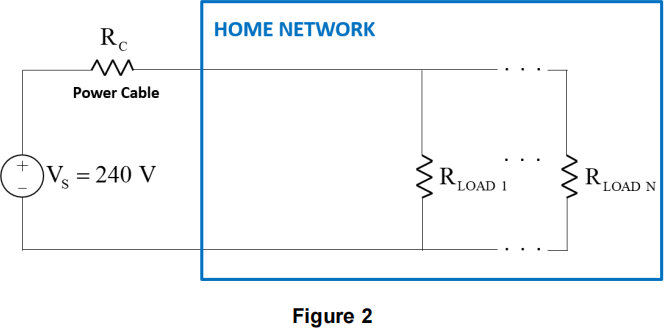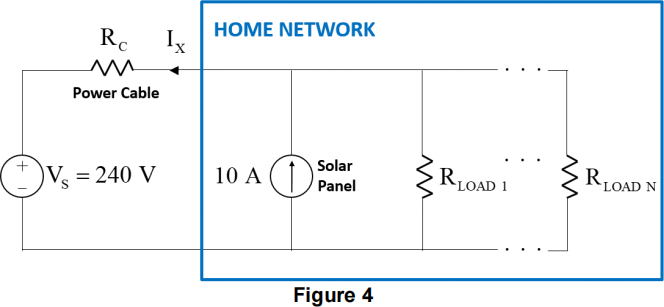EEEN10121 Coursework Assignment – Home Network Analysis
Hello, dear friend, you can consult us at any time if you have any questions, add WeChat: daixieit
Department of Electrical and Electronic Engineering
Unit EEEN10121
Semester 1. Year 2023/24
Unit: Circuit Analysis
Title: Coursework Assignment – Home Network Analysis
Last revision: October 2023
Aims: To encourage students to practice DC circuit analysis including DC power calculations using realistic application of a home network.
Key points: DC circuit analysis including DC power calculations, appreciation of real-world application of circuit analysis.
Background Information
This coursework assignment is concerned with the analysis of the domestic electrical networks. Although real-world power networks are analysed using AC circuit analysis, due to the fact that voltages and currents have sinusoidal waveforms, you will use DC Circuit Analysis in this particular assignment.
Generic model of the network considered in this coursework assignment is shown in Figure 1.

Note that the voltage source with the voltage VS denotes the ‘substation’ which connects home network to the rest of the UK power grid. Substations are very important components of power networks and usually contain transformers that step-down the medium/high voltage to the low voltage level. Also, substations contain appropriate protection devices that are used to prevent large-scale outages of the power system in the presence of the faults. In order to make this exercise as realistic as possible the voltage at the substation is set to be equal to VS = 240V. Figure 1 also shows that the home network is connected to a substation via the underground power cable that has resistance equal to RC.
Home network is represented using a number of loads which are connected in parallel. Each load is represented by an equivalent resistor whose value is calculated using the nominal voltage of 240V and the power rating of that load. Also, the home network may have renewable energy sources such as the Solar Panel which is represented as the 10 A current source shown in Figure 1.
In order to introduce variability to the results obtained from individual students, each of you will be provided with a table that lists a particular set of appliances (i.e. domestic loads), their power ratings and the time schedule of their typical operation during the 24-hour period.
Example of such table is shown in Table 1 that lists information for several domestic loads and the solar panel.

Student-specific table, similar to that shown in Table1, are provided to you electronically via email on Tuesday 31st of October 2023.
This coursework assignment is split into 3 parts that consider different scenarios. For each of the scenarios there is a set of questions that need to be answered by entering appropriate values in the boxes provided in the remainder of this document.
You may wish to use MultiSIM or other software package in order to solve the circuits considered in this coursework assignment. However, it is NOT necessary for you to use software packages in order to get the correct answers, especially for Part 1 and Part 2.
Part 1
In this part of the assignment it is assumed that the home network is connected to the substation with the voltage equal to 240V via an underground cable with the resistance denoted as RC. Also, it is assumed that the home network does not have any renewable generation in the form of the solar panels. So the equivalent circuit of such network is shown in Figure 2.
Please make sure that you refer to your student-specific table for the description of the particular domestic loads/appliances that you should consider.

Question 1.1
At 20:00 hours there is a difference of 20V between the voltage measured across the loads in the home network and the voltage measured at the substation.
Estimate the value of the underground cable resistance RC that would cause such a voltage difference.
[10 marks]
Question 1.2
Assume that the underground cable resistance is equal to RC = 5 Ω.
Calculate the value of the average current flowing from the substation into the home network during the time interval between 19:00 and 22:00.
[10 marks]
Question 1.3
Assume that the underground cable resistance is equal to RC = 5 Ω.
Calculate the peak power loss in the underground cable during the 24-hour time period.
[10 marks]
Question 1.4
Assume that the underground cable resistance is equal to RC = 5 Ω.
Calculate the total current flowing from the substation to the home network if all the available appliances are switched on (ignore the time schedule).
[10 marks]
Part 2
In this part of the assignment it is assumed that the home network is connected to the substation via an underground cable with the negligible resistance, i.e. RC = 0 Ω. Also, it is assumed that the home network has renewable generation in the form of the solar panels that can be represented as a current source that uniformly produces 10A of current from 7:00 to 19:00 hours. Equivalent circuit of such network is shown in Figure 3.
Please make sure that you refer to your student-specific table for the description of the particular domestic loads/appliances that you should consider.

Question 2.1
Calculate the current IX flowing from the home network back into the substation at 11:00 hours. Note direction of the current IX shown in Figure 3.
[10 marks]
Question 2.2
Calculate the total energy balance of the home network during the 24-hour period (which is the difference between the energy generated within home network and energy consumed in the home network).
Use the sign to indicate whether the home network is a net exporter (you should use negative ‘-‘ sign) or importer (you should use positive ‘+’ sign) of electrical energy. Unit for electrical energy could be Watt-hour (Wh) or Joule (J).
[15 marks]
Part 3
In the final part of the assignment it is assumed that the home network is connected to substation via an underground cable with the resistance denoted as RC. Also, it is assumed that the home network has renewable generation in the form of the solar panels that can be represented as a current source that uniformly produces 10 A of current from 7:00 to 19:00 hours. Equivalent circuit of such network is shown in Figure 4.
Please make sure that you refer to your student-specific table for the description of the particular domestic loads/appliances that you should consider.

Question 3.1
At 11:00 hours there is a difference of 20V between the voltage measured across the loads in the home network and the voltage measured at the substation.
Estimate the value of the underground cable resistance RC that would cause such a voltage difference.
[10 marks]
Question 3.2
Assume that the value of the underground cable resistance is equal to RC = 5 Ω.
Calculate the peak power loss in the underground cable during the 24-hour time period.
[10 marks]
Question 3.3
Assume that the value of the underground cable resistance is equal to RC = 5 Ω.
Calculate the total current flowing from the home network to the substation (i.e. IX shown in Figure 4) if all the available appliances are switched on (ignore the time schedule) and the Solar Panels are generating current that is equal to 10 A.
Use the sign to indicate whether this current is positive or negative.
[15 marks]
Total [100 marks]
2023-11-11